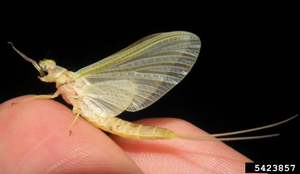Photo Credit: Jessica Louque, Smithers Viscient, Bugwood.org. License: Creative Commons Attribution 3.0 License (http://creativecommons.org/licenses/by/3.0/us/)
Hexagenia limbata
Common Name: giant mayfly
Animal Guild: Insect
Class > Order > Family: Insecta > Ephemeroptera > Ephemeridae
